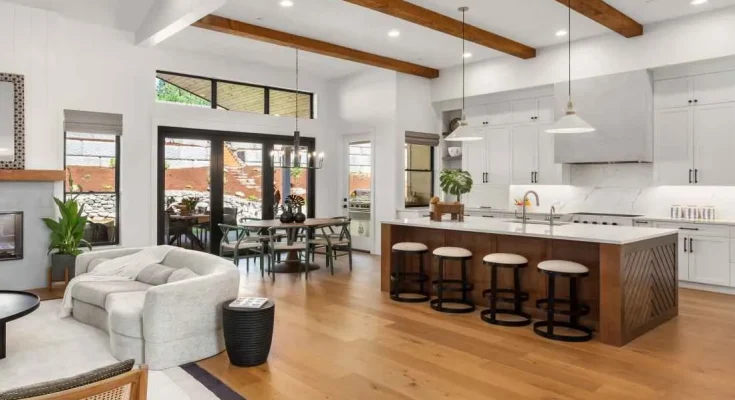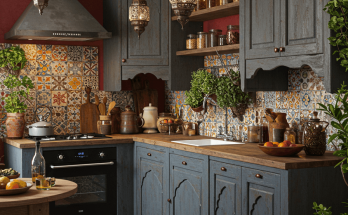The Principles of Sustainable Interior Design
Sustainable interior designfocuses on reducing the environmental impact of your living space by:
Using Sustainable Materials
Choosing sustainable materials involves opting for those that are renewable, recyclable, and non-toxic. Renewable materials, such as bamboo, cork, and reclaimed wood, are sourced from resources that can replenish naturally over time, reducing the strain on the environment. Recyclable materials, including certain metals, glass, and some plastics, can be reprocessed and used again, minimizing waste and conserving natural resources. Non-toxic materials are free from harmful chemicals, ensuring they are safe for both the environment and human health.
Energy Efficiency
Implementing energy-efficient solutions is crucial for reducing energy consumption and lowering environmental impact. This can be achieved by incorporating LED lighting, which uses significantly less energy and lasts much longer than traditional incandescent bulbs. Additionally, energy-efficient appliances, such as refrigerators, washing machines, and HVAC systems, are designed to operate using less electricity or gas, which helps in cutting down utility bills and reducing greenhouse gas emissions.
Waste Reduction
Waste reduction focuses on minimizing the amount of waste we produce and making better use of resources. This can be achieved by selecting products with minimal packaging, which reduces the amount of disposable materials that end up in landfills. Furthermore, choosing items that can be repurposed or recycled helps extend their lifecycle and prevent unnecessary waste.
Eco-Friendly Home Decor Ideas
Incorporating eco-friendly decor can be both stylish and sustainable:
Reclaimed Wood Furniture
Furniture crafted from reclaimed or recycled wood offers both environmental and aesthetic benefits. By repurposing wood from old barns, factories, warehouses, or even discarded furniture, we help reduce the demand for newly harvested timber, thus conserving forests and reducing deforestation. This approach also minimizes the waste that would otherwise end up in landfills. Each piece of reclaimed wood furniture carries its history, with unique imperfections, grains, and patinas that add character and charm to your home.
Organic Textiles
Using textiles made from organic cotton, bamboo, or hemp for bedding, upholstery, and curtains is a sustainable choice that promotes environmental and personal health. Organic cotton is grown without harmful pesticides or synthetic fertilizers, which helps protect soil quality and reduces water consumption. Bamboo is a fast-growing, renewable resource that requires minimal water and no pesticides to thrive, making it an eco-friendly option.
Natural Paints
Opting for natural paints and finishes that are low in VOCs (volatile organic compounds) significantly improves indoor air quality and creates a healthier living space. Traditional paints often contain high levels of VOCs, which can off-gas harmful chemicals into the air, causing respiratory issues, headaches, and other health problems. Low-VOC and zero-VOC paints, on the other hand, are formulated with fewer hazardous chemicals, making them safer for both the environment and your family.
Green Interior Design Practices
Implementing green design practices can significantly enhance the sustainability of your home by reducing your environmental impact and creating a healthier living space.
Indoor Plants
Adding plants to your interior decor not only enhances the aesthetic appeal of your home but also improves air quality by absorbing pollutants and releasing oxygen. Plants like spider plants, peace lilies, and snake plants are particularly effective at filtering indoor air, making your home a fresher, more pleasant place to live.
Water-Saving Fixtures
Installing low-flow faucets and showerheads is an effective way to reduce water consumption without sacrificing performance. These fixtures use advanced technology to maintain water pressure while using significantly less water, helping to conserve this precious resource and lower your utility bills.
Solar Panels
Investing in solar panels allows you to harness renewable energy from the sun to power your home. This can dramatically reduce your reliance on fossil fuels, lower your electricity costs, and even allow you to sell excess energy back to the grid. Over time, solar panels can pay for themselves and provide a sustainable, eco-friendly energy source.
Sustainable Materials for Interior Design
Choosing sustainable materials is a cornerstone of eco-friendly design, ensuring that your home is both beautiful and kind to the environment.
Bamboo
Bamboo is a fast-growing, renewable resource that is incredibly versatile and durable, making it an excellent choice for flooring and furniture. Its rapid growth rate means it can be harvested without causing long-term damage to the ecosystem, and its strength and aesthetic appeal make it a popular choice for modern interiors.
Cork
Cork is harvested from the bark of cork oak trees, which regenerate their bark, making it a renewable and sustainable material. It is excellent for flooring and wall coverings due to its natural insulating properties, durability, and unique texture. Cork is also hypoallergenic and resistant to mold and mildew, making it a healthy choice for your home.
Recycled Metals
Using recycled steel, aluminum, and other metals for furniture and fixtures reduces the demand for new raw materials and the energy-intensive processes required to produce them. Recycled metals are just as strong and versatile as new metals, and they add a modern, industrial touch to your interior design.
Practical Tips for Green Interior Design
Implementing practical green design tipscan help make your home more energy-efficient and environmentally friendly.
Energy-Efficient Windows
Installing double-glazed windows helps reduce heat loss in the winter and heat gain in the summer, significantly improving your home’s energy efficiency. Double glazing consists of two panes of glass with a layer of inert gas or air between them, providing better insulation and reducing the need for heating and cooling.
Natural Lighting
Maximizing natural light in your home reduces the need for artificial lighting and can create a more inviting and uplifting atmosphere. Strategically place windows, skylights, and light tubes to capture natural sunlight, and use light-colored walls and reflective surfaces to enhance the light distribution.
Insulation
Proper insulation is crucial for maintaining a comfortable indoor temperature and reducing energy consumption for heating and cooling. Insulate your walls, attic, and floors to keep your home warm in the winter and cool in the summer.
Conclusion
Embracing sustainable interior design not only benefits the environment but also enhances the comfort and health of your home. By integrating eco-friendly materials and practices, you can create a stylish, green living space that reflects your commitment to sustainability. From reclaimed wood furniture to energy-efficient windows, the possibilities for sustainable design are vast and rewarding.
FAQs about Sustainable Interior Design
What is sustainable interior design?
Sustainable interior design involves creating living spaces that minimize environmental impact through the use of eco-friendly materials, energy-efficient solutions, and waste-reduction practices.
What are some examples of sustainable materials?
Examples include bamboo, cork, reclaimed wood, organic textiles, and recycled metals.
How can I make my home more energy-efficient?
Use energy-efficient appliances, install LED lighting, and double-glazed windows, and ensure proper insulation.
What are some eco-friendly home decor ideas?
Incorporate reclaimed wood furniture, organic textiles, indoor plants, and natural paints to enhance your home’s sustainability.
Why is sustainable interior design important?
Sustainable interior design reduces environmental impact, improves indoor air quality, conserves resources, and promotes a healthier living environment.



